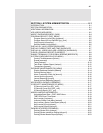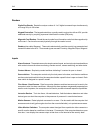
1-2 SECTION 1: INTRODUCTION
Documentation Methods
To avoid repetition and to reduce document size, detailed explanations for the system's principal
data items are given only in Section 4: Master File Entry, which is used when creating the system
database. For introductory information concerning the data items, see Definitions below.
Further, with the exception of the screens presented in Basic System Usage in this section, and
the introductory menu screens for Sections 2 through Section 5, all other screens throughout this
manual are limited to the particular screen area being discussed (i.e., full screens are not shown).
In some cases, screen presentations are unnecessary and are not used.
DEFINITIONS
General
Access Code. A group of readers and time codes assigned to keyholders indicating where and
when entry is permitted. Note that access codes can be associated with a down loadable device
ID for distributed processing or they can be associated with the host computer for central
processing.
Access Group. A group of access codes created to facilitate the assignment of similar access
privileges to a large number of keyholders.
Alarm Contact. A dry-contact switch, indicating input conditions for smoke detectors, heat /
moisture sensors, taut-wire fences, window bands, etc.
Company. Keyholder's employer.
Department. A particular group within a company to which a keyholder is assigned.
Device. A controlling element of the system which communicates with the computer and the
system points (see System Hardware in this section).
Event. Any defined transaction which requires action by an access control system. Examples:
keyholder entry request, activated alarm.
Job Category. A code assigned to a keyholder indicating the employee group category.
Key Number. Keyholder's security key number. Unlike the keyholder ID, this number may be
changed (e.g., if a key is lost) or removed (e.g., if an employee leaves the company).
Keyholder. Employee or visitor who holds a valid security card for an access control system.


















